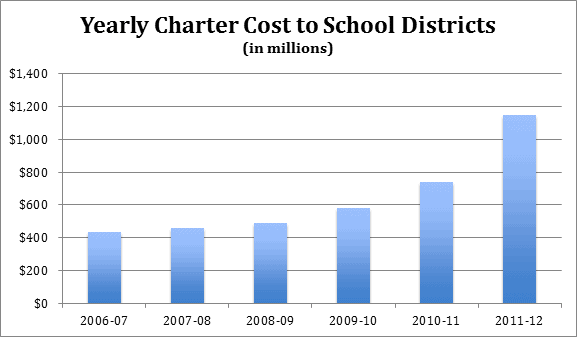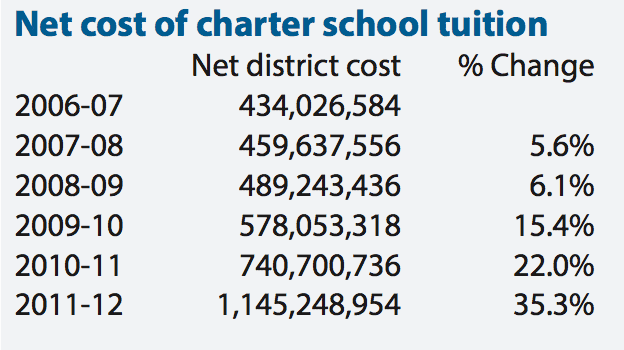The last few years have been tough for Pennsylvania schools, with budget shortfalls forced on school districts around the state by draconian cuts to the education budget. With nearly a billion dollars less in the education coffers, districts have been forced to cut programs and staff. But what has been a disaster for public schools has been a windfall for charter and cyber schools, with their budgets increasing every year—with each year a significantly higher boost than the year before—to the point where funding is up 164% over the last five years. Unfortunately, this money is coming directly out of the pockets of public schools, while charter and cyber schools are sitting on more than $400 million in reserves.

Source: PA Department of Education
The Pennsylvania charter law was passed under the belief that charter schools could give a better option to public school students while relieving some of the burden on overcrowded, cash strapped districts. While some charter schools are better options than their public counterparts, they have the luxury of operating with a surplus instead of the deficit forced on school districts by a state unwilling to pay its fair share.
As for helping districts save money by taking students off their hands, the Pennsylvania School Boards Association found that “school districts are not saving money…In most cases, only a handful of students from each school attend charters, meaning districts are unable to reduce overhead costs. Neither are school districts able to reduce the size of their faculty or staff.” So districts are doubly hit, having to pay charters while not realizing any financial savings.
Now about those overhead costs. Act 22, the Pennsylvania charter law, created a formula where funding “follows a child” from a district to a charter. Makes sense, right? It would if that money would be fully spent on that child’s education. According to Act 22’s formula, it is not purely the education costs that get passed on, but building maintenance, transportation, and athletic and music programs that the charter may not have. Rather than calculating the costs that the charter needs to fill, Act 22 just gives them the money that the district was spending regardless. But what about cyber charters, you may ask, they don’t have “brick and mortar” facilities to worry about, aren’t they saving school districts a ton of money? In a word: no. The cyber charters are funded the same as their brick and mortar counterparts. So what are they doing with all that extra cash from the schools they don’t have to heat, the football stands they don’t have to build and the tubas they don’t have to buy?
Back to those rising charter costs. The state used to have a solution: it would reimburse districts for a large chunk of their charter payments, to make up the difference for what they were losing in non-education costs. In one of Governor Corbett’s more baffling cuts, however, the $220 million (and rising as of 2009-10) Charter School Reimbursement line was cut out of the budget. This is not a political issue, or at least, it did not used to be. The program was started by Tom Ridge. Without it, school districts have been hit hard, but according to PCCY’s analysis, none have been hit harder than the School District of Philadelphia. Back in 2006-7, Philadelphia paid out $240 million to charter schools, although it was still getting nearly a third of that back from the state. In the 2012-3 school year, with no reimbursement, those costs spiraled to about $600 million.
Charter schools are not inherently bad, but Pennsylvania’s funding system for charters is. Like doctors, Pennsylvania’s legislators should take an oath when it comes to education funding: first, do no harm. The state needs to more skillfully regulate the financial system for supporting charters so that charters, especially cyber charters, are not being paid more than they spend. That will take some time. But they can immediately reinstitute that Charter Reimbursement line, which will take a lot of pressure off of our cash-strapped districts and refocus the education conversation where it should be – how to make sure every school, charter or traditional public school, has the funds needed to guarantee every child a high quality education.

